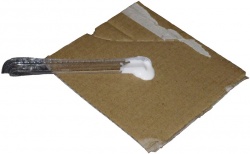Wood glues
Most wood glues need to be clamped while the glue dries to achieve maximum bond strength. Very little glue is needed to bond pieces of wood together.
Types of Wood Glue
Many substances have been used as glues. The most common wood glue is polyvinyl acetate (PVA), also known as "carpenter's glue" or "Yellow glue". The white version of polyvinyl acetate is also used on wood. Epoxy is sometimes used where bond failure could cause injury. PVA:
- polyvinyl acetate (PVA), yellow - carpenter's glue, various versions/grades available
- polyvinyl acetate (PVA), white - cheap, slower setting, more chance of a clamped joint moving before its set. white can also be bought from kids' supplies shops.
Animal glues were once ubiquitous, especially hide glue, which is still used in lutherie and restoration. These are bought in pellet form, and added to water in a heated pot to liquify. They're very fast setting glues.
Polyurethane glue (eg Deckbond) is more water resistant that pva, and better at gap filling. PU foams very slightly, the foam fills whatever gaps the liquid doesn't, but PU foam has very little strength. Dampening the surfaces to be glued helps it foam more & set quicker.
Cyanoacrylate (Superglue) used mainly for small repairs, especially by woodturners. Also used as a durable varnish for small pieces
contact cement solvent based, for veneers
hot melt for temporary uses, not the best bond to timber, tends to pull off after a while
Epoxy very tough, bonds securely, fills gaps well. Mainly for structural & exterior uses
Other synthetic resins including resorcinol, urea-formaldehyde, phenol formaldehyde resin, etc.
Wood resin - not used much now, but has its applications. Heat pine or spruce scrap to get the resin to ooze out. Resin is quite flammable and smells (pleasantly) until totally dried out, and is very slow to dry. Has a lot of grab when stiffish. Good for marquetry & parquetry. Reliquified by petrochemical solvents & heat.
Exterior Use
Wood glues intended for exterior use vary in their suceptibility to water. But even totally waterproof glue is best avoided in most outdoor uses, as:
- wood swells & shrinks outdoors
- most outdoor glues aren't entirely waterproof
- glue can sometimes hinder drying & preservative penetration
- many timber preservatives affect glue bonding
Glues:
- PVA (exterior grade)
- Polyurethane - survives frequent showers but not constant wet or damp
- Hide glue
- Cyanoacrylate
- Contact cement
- Hot melt - some are fully waterproof, not pva. not the strongest
- Epoxy - totally completely waterproof
- Resorcinol
- Urea-formaldehyde
- Phenol formaldehyde resin
Trade & other names
- PVA, yellow - carpenter's glue, yellow glue
- PVA, white - Elmer's, white glue.
- Polyurethane - Deckbond
- Hide glue - animal glue,
- Cyanoacrylate - Superglue, crazy glue
- Contact cement
- Hot melt
- Epoxy - Araldite
- Resorcinol
- Urea-formaldehyde
- Phenol formaldehyde resin
References
Patrick Spielman (1986). Gluing and Clamping: A Woodworker’s Handbook. Sterling Publishing. ISBN 0-8069-6274-7
